Posts Tagged ‘ecological burn’
Thursday, September 13th, 2012
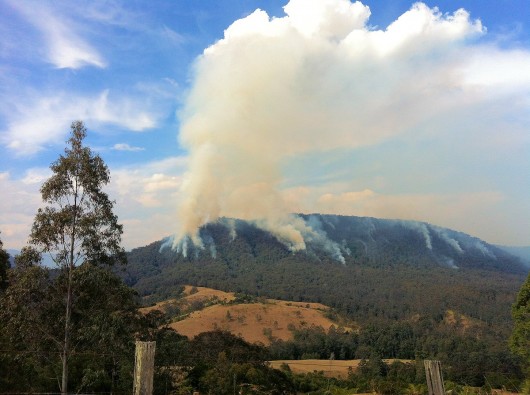 NSW National Parks and Wildlife Service setting fire to native habitat while the weather is calm.
What fauna, it’s an ‘Ecological Burn’?
This week’s hazard reduction burn in Barrington Tops NP, north of Dungog
[Source: Photo by Andy Boleyn, ^http://newcastleonhunter.com/2012/08/npws-burning-down-the-tops/] NSW National Parks and Wildlife Service setting fire to native habitat while the weather is calm.
What fauna, it’s an ‘Ecological Burn’?
This week’s hazard reduction burn in Barrington Tops NP, north of Dungog
[Source: Photo by Andy Boleyn, ^http://newcastleonhunter.com/2012/08/npws-burning-down-the-tops/]
.
It’s that time of year across Australia, when bush arson is deemed acceptable (even noble) , so long as it is ‘prescribed‘ by government, even when it often gets out of control.
Australia’s native habitat is deliberately set fire to by Australian Government agencies every year, just in case it burns, which means that frequently they can’t put it out.
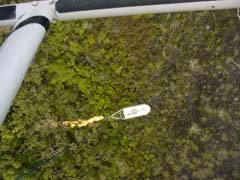 Dropping petrol bombs by immoral helicopter pilots Dropping petrol bombs by immoral helicopter pilots
..”hey man, this is like Nam all over again!”
.
None of the arson rationale respects native wildlife, as with illegal bush arsonists. There is little difference on wildlife impact as to who sets fire to their habitat – illegal or government sanctioned. In the above burn, Acting NPWS Barrington Tops Area Manager Peter Beard, justifies setting fire to wildlife habitat thus:
.
“Hazard reduction burn aims to protect lives and property, whilst maintaining the biodiversity of the World Heritage-listed park.”
.
Yet it is carried out without any thought or knowledge about the ecological impacts upon ground dwelling fauna populations or upon flora species that are fire sensitive nor the complex and fragile co-existences. Where are the independent scientific wildlife counts before and after each prescribed arson sortie? Where is the qualified wildlife ecologist’s report that made public that says burning this forest is not harmful?
The fire lighting is not even mosaic. It is blanket, broadscale and indiscriminate. Aerial incendiaries are dropped along the ridge top by helicopter casuing multiple ignition points so that the fire takes hold.
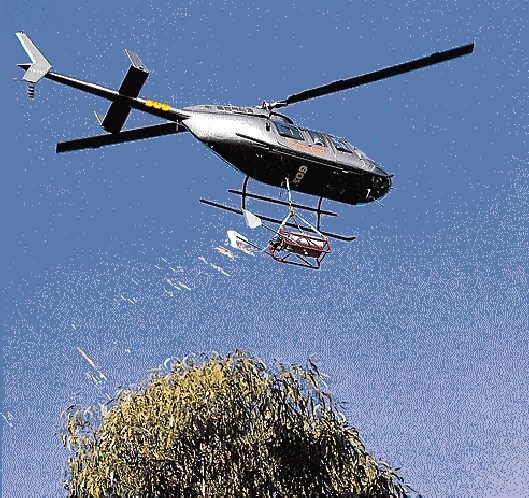 Aerial ‘habitat reduction’ occurs across National Parks and World Heritage Areas
– no habitat is sacrosanct.
It is euphemistically branded ‘Biodiversity Burning’ – fire is good for wildlife – watch them run, watch the Echinas and Wombats burn! Aerial ‘habitat reduction’ occurs across National Parks and World Heritage Areas
– no habitat is sacrosanct.
It is euphemistically branded ‘Biodiversity Burning’ – fire is good for wildlife – watch them run, watch the Echinas and Wombats burn!
.
It is one of many hundred being conducted across New South Wales native landscapes by the National Parks and Wildlife Services as well as by the Rural Fires Service and with assistance from regional fire brigades. Another 25 burns covering 6000ha are planned in the next week, including burns in In Ku-ring-gai Chase National Park and the Blue Mountains World Heritage Area.
Rather through unrelenting government propaganda, all Australian native vegetation is demonised as a ‘threat‘, a ‘hazard‘ and as ‘fuel‘ – just like the Christian church has for centuries demonised non-believers as heathens.
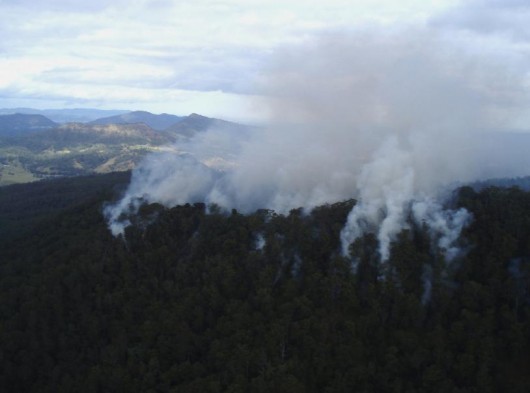 National Parks are deemed by Australian governments as a ‘hazards’!
It is a town park mentality – a bit of greenery for people to enjoy at weekends. National Parks are deemed by Australian governments as a ‘hazards’!
It is a town park mentality – a bit of greenery for people to enjoy at weekends.
.
It doesn’t take much effort by a layperson to access a computer, download Google Earth and zoom into New South Wales, then to realise that the native vegetation that remains is dotted in islands within vast landscapes of denuded cleared farmland, and then to respect that if the native wildlife exist anywhere, they are in these vegetation islands.
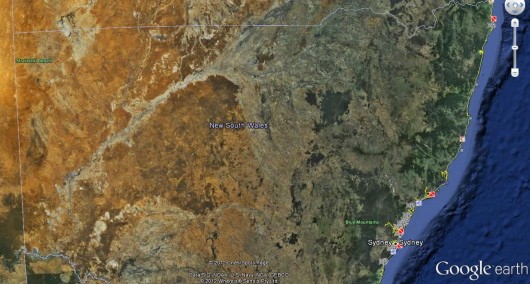 This is Destination New South Wales..
about 90% deforested, or burned, or farmed, or mined, or housed or else deserted This is Destination New South Wales..
about 90% deforested, or burned, or farmed, or mined, or housed or else deserted
‘NSW.. see where it takes you’..enjoy!
[Click image to enlarge, or visit Google Earth’s website]
.
“There are some amazing natural attractions in New South Wales. From the coast to the country you’re spoilt for choice. All over this state you can meander at your own pace and discover a whole world of extraordinary natural wonders. With close to 900 ^NSW national parks, forests and reserves, the State features the most diverse nature experiences in Australia ranging from rainforests, marine parks, a city within a national park, outback landscapes, mountains, islands and World-heritage listed areas.”
[Source: New South Wales Tourism Department, ^http://www.visitnsw.com/things-to-do/nature-and-parks]
.
Then for these islands of native vegetation to be deliberately set fire to can only contribue to native wildlife extinctions. It doesn’t take more than a lay person to realise this by deduction. Yet wildlife extinction is exactly what these senseless fatalistic government bush arson culls are doing every year. Setting fire to wildlife habitat is wildlife desecration, just like an invading army razing a village.
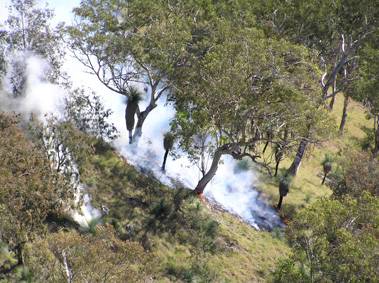
Rural fire agencies throughout Australia are no different in mindset to paid professional urban fire brigades – their mandate is to serve only to protect human life and property – but all native vegetation and wildlife is demonised as a liability and dismissed as only a risk to human life and property. The key distinction between rural fire fighters and their urban counterparts is that the urban fire fighters are paid professionals. Governments save billions by not paying rural firefighters and by not training them to the skill level of urban firefighters – yet operationally their job is exactly the same. Volunteers have been conned by governments to being cheap fingers in the dyke, so that taxes can be channelled elsewhere instead of properly into emergency management.
When there is a wildfire under extreme bushfire weather conditions, the ill-equipped, under=prepared and under-resourced bushfire agenecies know full well, that they cannot reliably detect, reach or suppress ignitions most of the time. They are depressing forced to rely upon the vagrancies of wind changes to dictate the impact of wildfires and the fate to lives and property.
So that is why government is so keen to prescribe preventative fighting fire with fire. If the bush is burned so that there is litte to burn then when a wildfire erupts in hot, dry and windy conditions the risk is less.
.
.. one has to destroy the village to save it!
.
Oddly this mindset is not allowed to apply to plantation forests – because they are deemed ‘economic assets’ and so therefor evaluable and therefore worth protecting from fire.
Of course, after every major fire involving loss of human life, such as in Victoria in 2009, all the politicians come out crying “shocking, shocking, shocking”, promising expensive enquiries, promising more resourcing, and that it will never happen again. All the while, politicians full well know that when the media cameras lose interest, it is cheap volunteer business as usual, because by the time the next wildfire, they will be happily lifestyle pensioned out – polly gold card privileges and all.
The Victorian Bushfires of 2009 that caused the deaths of 173 people were in the main caused initially by either powerline neglect and arson. The fire brigade was not prepared for a catastrophe despite the bushfire danger index forecast days before to be well off the scale. The underprepared, under-resourced Dad’s Army preparedness contributed to the 173 deaths.
Instead, all Australian and State governments have blamed the Australian wildlife habitat for being the fuel like and ‘accessory before the fact’. It was the victim.
So hazard reduction is now ramped up Australia wide. In New South Wales hazard reduction this year is the NSW Government’s response strategy, costing $62 million “to boost wildfire preparedness“. Under the NSW NPWS ‘Enhanced Bushfire Management Programme’, NPWS aims to double the number of hazard reduction hectares each year, for the next five years. NSW Environment Minister Robyn Parker said hazard reduction work is part of an ongoing State-wide operation.
If there is unburnt bush, it will be targeted for burning! Burn it before it burns, god damn! If the Rural Fire Starters had access to B52s and Agent Orange, they sure the would deploy both, such is the inculcated bushphobic mindset.
“NPWS crews are already taking advantage of favourable spring weather to carry out 12 burns covering more than 2,500 hectares of national park in the past fortnight.”
The NSW Government is doing everything it can to reduce the risk of fire, including in our national parks – particularly with a drier, hotter summer than we’ve recently experience predicted.”
[Source: ^http://newcastleonhunter.com/2012/08/npws-burning-down-the-tops/]
.
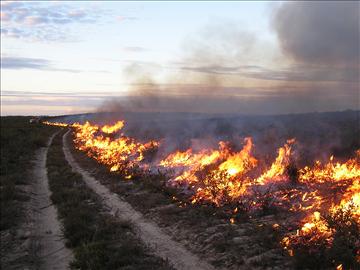 Broadscale Hazard Reduction
‘So when summer comes we should be right – there’ll be nothing left to burn!’
‘Job Done!‘ Broadscale Hazard Reduction
‘So when summer comes we should be right – there’ll be nothing left to burn!’
‘Job Done!‘
.
It is a wicked species-anhilating strategy that most in the broader community ignorantly accept as justified, because government propaganda threats say so and because few folk have the wisdom or courage to dare question the propaganda.
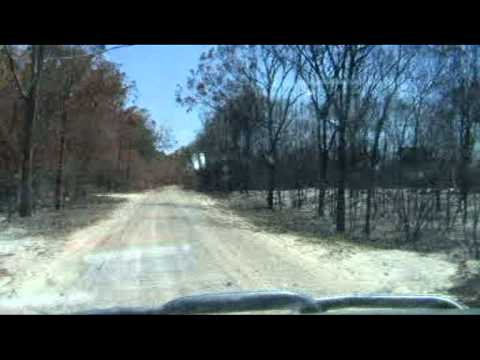 Woops, the prescribed burn got out of control
That’s ok its only Fraser Island World Heritage – it’ll grow back! Woops, the prescribed burn got out of control
That’s ok its only Fraser Island World Heritage – it’ll grow back!
.
Last weekend, a 12-year-old boy was charged with lighting a bushfire at Watannobi on the Central Coast around lunch time. Just like the fire fighters he must be watching and learning from, the bushfire was lit using multiple ignition points so that it took hold. Sure enough, the blaze quickly escalated. In the end some eighty hectares of native vegetation and grassland were burnt before the fire was contained in the mid afternoon.
He may be charged now, but no doubt he is recruitment material for the local Rural Fire Starters when he gets older.
But unlike the State-sanctioned arsonists, the boy was publicly apologetic for what he had done, realising that it was wrong. To his credit he said:
.
“I’m sorry for what I have done .. and I won’t do it again.”
.
[Source: ‘Boy apologises for lighting F3 Fire’, Seven News (Sydney television), 20120911, ^http://au.news.yahoo.com/video/national/watch/30549030/boy-apologises-for-lighting-f3-fire/]
.
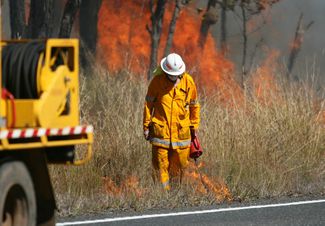 Government-sanctioned arsonists know what they are doing is wrong
– but the Firie peer pressure is too great Government-sanctioned arsonists know what they are doing is wrong
– but the Firie peer pressure is too great
.
Why don’t gardeners of Australian native gardens follow the National Parks biodiversity burning mantra and set fire to their gardens? Because they respect the unburnt value of Australia’s flora.
.
Why do we not see much wildlife anymore in National Parks?
.
Thursday, May 26th, 2011
[The following article has been borrowed from a section of a previous article on this website: ‘Blue Mountains copping government-arson‘, since this important message has ramifications beyond the natural areas of the Blue Mountains].
.
– – – – – –
.
.
From the frying pan…
.
When bushfire management can contrive no other excuse for setting fire to native vegetation, like when native vegetation is many miles away from human settlement and so poses no direct threat; out comes a concocted academic theory called: ‘ecological burning ‘. Over how many beers?
When those in whom our community trusts to put out bushfires, decide instead to start setting fires to bushland, and descend instantly into a betrayal of that that trust, to whom can our community entrust to put out bushfires? Government has been proven to suck.
What has happened to ecological values of the bush and the sense of urgency to put out bushfires that threaten both it and us?

.
‘Ecological Burn’ Theory
.
- The ‘ecological burn’ theory starts with the premise that because humans have observed that the Australian bush ‘grows back’ (eventually) after a bushfire, it may be concluded that the Australian bush can tolerate bushfires. This hypothesis relies on evidence that selected species of Australian germinate after smoke and fire and the example of epicormic growth of many Eucalypts after fire.
- The deductive fallacy of this theory is that all the Australian bush is bushfire tolerant.
- This deduction is then extended by unsupported assumption that since the Australian bush is bushfire-tolerant, bushfire must be an integral natural process to which the Australian bush has become adapted to bushfire.
- The assumption is then extrapolated to assert that bushfire is indeed beneficial to the Australian bush.
- The assumption is then stretched even further to conclude that without bushfire the Australian bush will be adversely affected.
- The ecological burn theory then prescribes that by burning the Australian bush, whether by natural or unnatural means, the biodiversity of the Australian bush will be improved.
- The deductive fallacy goes further, to suit the motives of the fire-lighters. The outrageous generalisation is made that all the Australian bush must be burnt at some stage for its own ecological benefit.
.
So the ‘Ecological Burn’ mantra has become:
‘Go forth and burn wilderness. It’ll grow back. It’ll do it good.‘
.
.
Habitat ‘fuel’ gone…so it wont burn now!
.
The perverted irrational logic that Australia’s native vegetation has adapted to recover from bushfire is akin to claiming the human body is adapted to recover from injury such as burns. A wound may heal but no-one seeks to be injured in the first place. And not all wounds heal. A third degree burn to more than 50% of a human body is almost a certain death sentence. What percentage of a wild animal’s body can be burnt and the animal still survive? That’s a perverted question for the fire-lighters.
Broadscale hazard reduction is not mosaic patch-work fire. It is not creating a small scale asset protection zone around the immediate boundary of a human settlement. It is wholesale bush arson that is driving local extinctions. Ever wonder why when bush walking through the Australian bush so few native animals are seen these days? Their natural populations have been decimated through two centuries of human harm – mainly poaching, introduced predation and habitat destruction including by human-caused bushfires and human-abandoned bushfires.
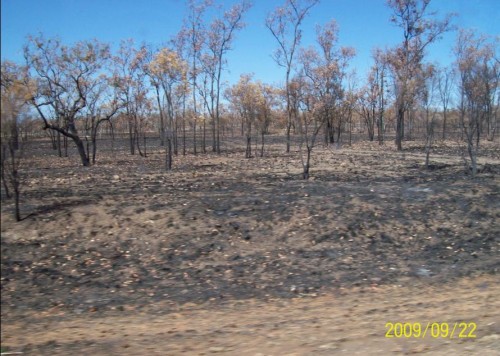 Broadscale incineration of native bushland across northern Queensland
by the Rural Fire Service Queensland.
Habitat ‘fuel’ gone ~ so it won’t burn now! Broadscale incineration of native bushland across northern Queensland
by the Rural Fire Service Queensland.
Habitat ‘fuel’ gone ~ so it won’t burn now!
©Photo by Ann Jurrjens, 20090922.
(click photo to enlarge, then click again to enlarge again).
..
.
.
.
Likely Origins of the ‘Ecological Burn’ myth
.
The concept of the ‘ecological burn’ sounds like the academic contrivance that it is. It is an outpouring from a handful of forestry academics who have successfully sold their consulting services to government under a similarly contrived expertise of being ‘fire ecologists‘ or ‘fire scientists‘. Well, at least ‘garbologists‘ work for a living.
After a major bushfire, an affected and sometimes devastated public cries for answers and the media cash in with their newspaper-selling witch hunt. The responsible government politicians and department directors of the bushfire management deflect accountability away from themselves by instigating a tried and tested ‘bushfire enquiry‘. Those enquiries seek expert evidence and so the ‘fire ecologists’ come out of the woodwork, professing expert insight into the reasons for uncontrolled bushfire and contriving theories for better bushfire management. They invariably proclaim ‘I told you so!
With the frequency of uncontrolled bushfires year after year, there have been so many enquiries across Australia, sufficient to fill bookshelves; each one wastefully gathering dust. Yet with the almost annual disaster recurrence somewhere across Australia, the relevance of ‘fire ecologists’ has morphed fire ecology into an almost full-time occupation – generally on the payroll of the government agencies seeking to justify excuses why they didn’t put out the bushfires in the first place.
The origins of ‘fire ecology’ and to the ‘ecological burn’ theory may be at least traced back to Victoria, an Australian state with perhaps the worst record of bushfire management in the country. During 1999 a series of ‘Fire Ecology Workshops’ were held at Country Fire Authority stations across the state. In that year the ‘Interim Guidelines an Procedures for Ecological Burning‘ was published by Victorian Government’s departments: Natural Resources and Environment and Parks Victoria. References to this and related documents may be found by following the links under References below.
It must have been like an evangelistic mission by these new ‘fire ecologists’, leveraging the common human terror of fire into a way of dealing with that fear once and for all. The final solution would go beyond ‘back-burning‘, beyond the ‘controlled burn‘, beyond ‘hazard reduction‘. It means burning the bush before it burns; but this time on a massive scale, taking the fire-fight to wilderness.
The ‘ecological burn’ theory has gone further. It has brainwashed fire-fighters and natural land managers into believing that burning the bush is indeed good for the bush, good for biodiversity. This is a paradigm cultural shift to a sense of ecological righteousness – by burning the bush you are doing biodiversity a favour. And the fire scientists’ proof of their theory is down to the epicormic growth and the selected native plant species shown to be fire-tolerant, and with that fire-tolerance must be ecologically sustainability. As soon as some green regrowth occurs, they are out taking photos to support and promulgate their theory. ‘Look it grows back’ they claim. Except that these same species that recover from fire have ended up dominating the natural landscape.
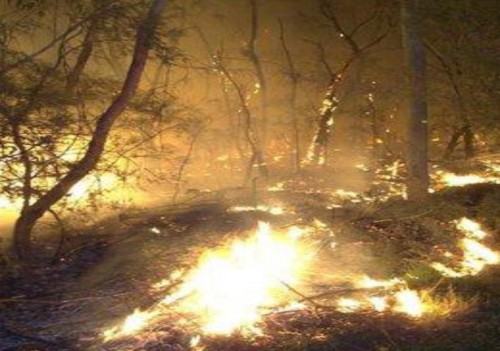 Fire-Lighters’ bliss
.
Fire-Lighters’ bliss
.
‘A Firelighters’ Bliss‘:.
‘a state of profound satisfaction in lighting a bushfire, the equivalent happiness and joy in doing so, a constant pyromaniac state of mind, undisturbed by gain or loss, so long as the lit bush burns fiercely’. i.e. the aroused state of ignition frenzy by either a closet, suspected or convicted bush-arsonist!
.
So forget Aboriginal traditional mosaic burning theory – so passé and so ineffective (below napalm baseline). So the message is officially clear, if you want to avert calamities like Black Friday, Black Saturday and the demonising of the rest of the days of the week, burn the bush in swathes, lest it burn you first. The theory is ecological satanism. It is up there with the Y2K bug. It has led a wholesale conversion of bush fire-fighters into fire-lighters on a grand scale akin to scientology’s hold on young people in the 1970s. It has culminated in an escalation of prescribed burning to an extent well outside any reasonable justification for protecting human life and property from the risk of bushfire. The ‘ecological burning’ extremists evangelise is that burning should be ‘strategic’ and for strategic zones spanning thousands of hectares of wilderness to be targeted for burning. What they avoid problem-solving is why they don’t put out the ignitions in the first place.
‘Ecological fire’ is a myth that has festered into the greatest ‘eco-crime’ in Australia’s history, second only to 19th and 20th Century widespread clear-felling. The ‘ecological fire’ myth is the most devastating driver of man-made extinctions plaguing Australia in the 21st Century.
.
A Test for ‘Fire Ecologists’:
.
Name one case study in Australia published in a peer-recognised scientific journal… in which independent wildlife ecologists have conducted proper before-and-after field tests of fauna-and-flora-biodiversity…where natural (pre-1788) biodiversity has been found to flourish… as a provable result of a broadscale ecological burn!
.
In August 2000, possibly the country’s chief druid of bushphobia, Kevin Tolhurst, produced a report seeking to justify the previous year’s setting fire to most of the Mount Cole State Forest, situated over 20km east of the town of Ararat in Victoria’s central west district. At the time, Tolhurst was part of the School of Forestry at the University of Melbourne.
Part of the report included, Appendix 3: Guidelines for the Ecological Burning in foothill forests of Victoria, in which an overview of the Mt Cole Case Study was provided. Notably, this report is provided not found on the University of Melbourne website, but that of the Department of Primary Industries of Victoria website. Clearly the ‘ecological burning’ concept stems not from preferred prestigious academic credentials, but moreso from politically motivated Primary Industries exploitive expedience.
The primary vegetation types targeted were ‘grassy dry forest’ and ‘herb-rich foothill forest’ which had not been burnt for an estimated 35 years, according the Natural Resources and Environment (Vic) corporate GIS database.
.
Tolhurst’s report states:
“Mt Cole State Forest was selected on the basis of having extensive areas of long-unburnt vegetation. A couple of areas within the forest had already been earmarked for prescribed burning from a fire-protection point of view. Mt Cole is an extensive area of easily defined forest with a wide range (of) vegetation types, ages, uses and values. The landscape management unit used in this example is about 32,000 ha in extent if which about half is forested and the other cleared for agriculture. There is little functional connection between this forest area and any other forest.”
“..The broad ecological management objective for Mt Cole State Forest, as part of the Midlands Forest Management Area is to : ‘Ensure that indigenous flora and fauna and communities survive and flourish throughout the Midlands Forest Management Area.”
…Flora and Fauna Inventory:
“Species found in study area as a result of a ramble survey of approximately 20 minutes at each location.”
.
Clearly, the motive underlying the so-called ‘ecological burning’ was the irrational fire-lighting cult fear of ‘long-unburnt vegetation’ daring to remain unburnt or so long – a symptom of bushphobia. ‘From a fire-protection point of view’ is the real motive and so it was convenient to just set fire to the lot. So some 32,000 hectares of a surviving island of native habitat was torched. After decades of agricultural land clearing Mt Cole State Forest had indeed been sadly reduced to having “little functional connection between this forest area and any other forest.” So why not just wipe the rest off the face the Earth? It probably stood out like a sore thumb coloured red for ‘high risk on ‘strategic’ CFA maps anyway.
And the blanket ‘ecological burn’ would see to it to ‘ensure that indigenous flora and fauna and communities survive and flourish throughout the Midlands Forest Management Area.”
Perhaps, post-burn, a similar 20 minute flora and fauna inventory was conducted in the CFA truck with a few tinnies, playing… ‘first-to-spot-the-first-bloated-blackened-wombat‘.
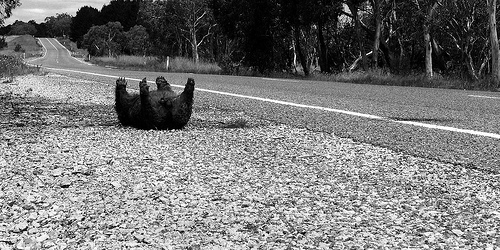 Dead Wombat Dead Wombat
.
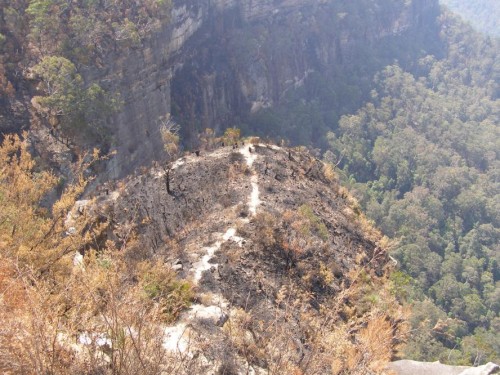
Defacto Hazard Reduction on the Grose Valley Escarpment, 2006
The fragile yet complex and vital soil biota of the escarpment built up over perhaps centuries,
gone after subsequent rain.
Habitat ‘fuel’ gone ~ so it won’t burn now!
(click photo, then click again for zoom details)
[Photo is ours, so free in public domain]
.
.
.
.
References
.
[1] ‘ Management of Fire for the Conservation of Biodiversity‘ – Workshop Proceedings, May 1999, Fire Ecology Working Group (Gordon Friend, Michael Leonard, Andrew MacLean, Ingrid Sieler), Natural Resources and Environment, Parks Victoria, ^ http://www.dpi.vic.gov.au/CA256F310024B628/0/0F55F0F75BFB3FCECA257231000D9F4D/$File/Mgt+of+fire+for+Cons+and+Biodiv.pdf.
.
[2] ‘Appendix 3: Guidelines for the Ecological Burning in foothill forests of Victoria’, Department of Primary Industry (Victoria) website, ^ http://www.dpi.vic.gov.au/CA256F310024B628/0/CC122443185E3E38CA257231001076A7/$File/MgtofCons_MtCole_CaseStudy_p21-27.pdf.
.
* Above references accessed 20110526.
.
.
– end of article –n
Tags: bush arson, bushfire tolerant, dead wombat, defacto hazard reduction, eco-crime, ecological burn, ecological burning, epicormic growth, fire ecologist, fire scientist, fire-lighter bliss, government bush-arson, hazard reduction, prescribed burning
Posted in 36 Tests of Harm!, Threats from Bushfire | 1 Comment »
Add this post to Del.icio.us - Digg
Saturday, May 21st, 2011
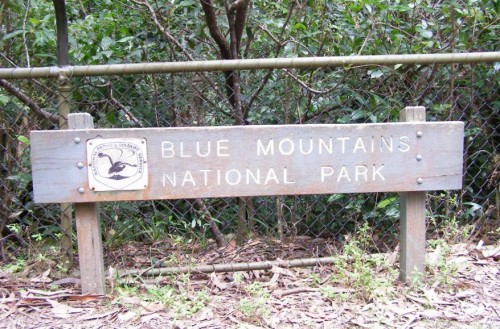
Wildlife Service sets fires to another 3000ha of World Heritage bushland
.
Last Wednesday (18th May 2011) right across the Blue Mountains, thick smoke choked the sky in a eye watering haze. By Friday, an artificial red sunset was blazing through the wood smoke at the end of two days of New South Wales government-sponsored bush arson.
I knew exactly the ecological disaster unfolding, out of sight out of mind.
In its annual misguided winter ritual, the National Parks and Wildlife Service (Wildlife Service), aided and abetted by the Rural Fire Service has deliberately setting fire to remote bushland across The Blue Mountains World Heritage Area – a ‘natural planet asset’ of which the Wildlife Service is international custodian.
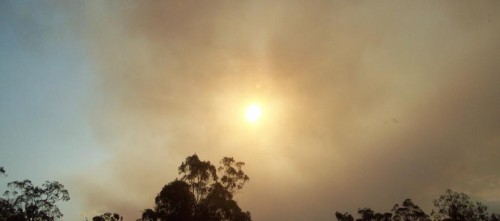
.
Linden Ridge HR Ops (May 2011)
.
On Wednesday afternoon 18th May 2011, the aerial incendiary bombing commenced at Linden Ridge and extended down to the Grose River inside the Blue Mountains National Park (within designated wilderness within the World Heritage Area). Bushfire management euphemistically call it ‘hazard reduction‘ (HR) ; rejecting any notion that bushland habitat is a natural asset, and instead demonising it as a ‘hazard’.
.
Massif Ridge HR Ops (May 2010)
.
The Linden Ridge ‘ops’ follows an almost identical HR ‘ops’ conducted the same time last year on 12 May 2010 in which aerial incendiary ‘ops’ commenced around Massif Ridge some 12 kilometres south of the town of Woodford in wild inaccessible forested area of the World Heritage Area. Some 2500 hectares of high conservation habitat bushland in a protected wilderness area called the ‘Blue Labyrinth’ was indiscriminately incinerated – ridgetops, gullies, everything. Refer to previous article on this website: >’National Parks burning biodiversity‘.
The same Blue Mountains National Park has been targeted by the same aerial incendiary bombing by the same Wildlife Service. Both the operations were carried out under the orders of the Blue Mountains regional manager, Geoff Luscombe.
 This is reducing the ‘hazard’
Click photo to enlarge, then click again to enlarge again and look for anything living.
After a year look for the animals.
After two years look for the animals…. This is reducing the ‘hazard’
Click photo to enlarge, then click again to enlarge again and look for anything living.
After a year look for the animals.
After two years look for the animals….
.
.
.
Gross Valley Defacto HR Ops (Nov 2006)
.
Both the above HR Ops follow the massive conflagration of November 2006, infamously recalled across the Blue Mountains community as ‘The Grose Fire‘. Two abandoned lightning strikes coupled with HR Ops along the Hartley Vale Road and escaping backburns coalesced and incinerated an estimated 14,070 hectares of the Grose Valley and adjoining ridge lands, much of which is designated wilderness. Many consider the actions of the bushfire management response in hindsight to have been a defacto hazard reduction burn. With such an effective elimination of the natural ‘hazard’ that year, as well as the public outrage, HR Ops went quite for four years.
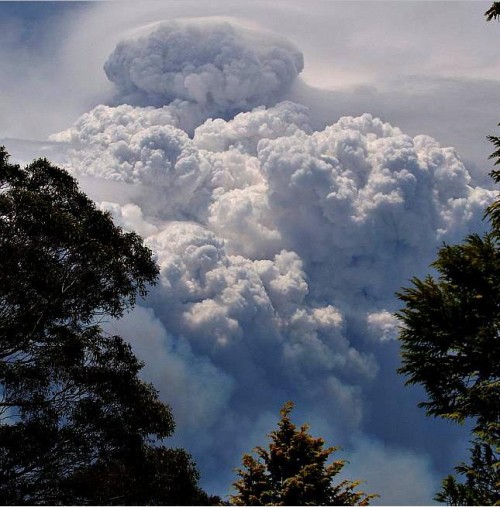
How many animals native to this beautiful Grose Valley suffered an horrific burning death?
How many of their kind have now perished forever from the Grose?
…ask your Wildlife Service at Blackheath!
Charles Darwin in 1836 counted platypus in the area.
.
The perverted rationalisation by bushfire lighting theorists who have infiltrated the Wildlife Service is that the natural bushland, forests and swamps of the Blue Mountains World Heritage Area are perceived not as a valuable natural asset, but as a world ‘hazard’ area to be feared and ‘to be burned in case they burn‘.
These same bushfire lighting theorists have effectively infiltrated, appeased and silenced local conservation groups such as the otherwise very vocal Blue Mountains Conservation Society, the National Parks Association of New South Wales and the umbrella conservation group the New South Wales Conservation Council.
The local conservation movement’s complicity to sanction explicit broadscale ecological harm is a disgraceful and ignoble abandonment of cherished core values, and a breach of duty to faithful environmental membership.
.
.
.
Broadscale indiscriminate ‘HR’ is no different to wildfire or bush arson
The Linden Ridge and Massif Ridge HR Ops were approved and executed by government in the name of ‘hazard reduction’ – to reduce the available ‘fuel’ (native vegetation) for potential future wildfires or bush arson. In both cases, the massive broadscale natural areas burnt were not careful mosaic low intensity burning around houses. This was broadscale indiscriminate fire bombing of remote natural bushland many miles from human settlement. How can the deliberate setting alight of bushland where no fire exists, where no human settlement requires protection from the risk of wildfire be construed but anything other than ‘government-sanctioned bush-arson‘?
.
The ‘Ecological Burn’ Myth
.
When bushfire management can contrive no other excuse for setting fire to native vegetation, such as when that vegetation is many miles away from human settlement and so poses no direct threat, out comes the concocted theory of the ‘ecological burn’. The ‘ecological burn’ theory starts with the premise that because humans have observed that the Australian bush ‘grows back’ (eventually) after a bushfire, it may be concluded that the Australian bush can tolerate bushfires. This hypothesis relies on evidence that selected species of Australian germinate after smoke and fire and the example of epicormic growth of many Eucalypts after fire.
The first deductive fallacy of this theory is that all the Australian bush is bushfire tolerant. This deduction is then extended by unsupported assumption that since the Australian bush is bushfire-tolerant, bushfire must be an integral natural process to which the Australian bush has become adapted to bushfire. The assumption is then extrapolated to assert that bushfire is indeed beneficial to the Australian bush. The assumption is then stretched even further to conclude that without bushfire the Australian bush will be adversely affected. The ecological burn theory then prescribes that by burning the Australian bush, whether by natural or unnatural means, the biodiversity of the Australian bush will be improved.
The deductive fallacy goes further, to suit the motives of the fire-lighters. The outrageous generalisation is made that all the Australian bush must be burnt at some stage for its own ecological benefit. ‘So go forth and burn it. The bush will grow back. It will do it good.’
.
The perverted irrational logic that Australia’s native vegetation has adapted to recover from fire, is akin to claiming the human body is adapted to recover from injury such as burns. A wound may heal but no-one seeks to be injured in the first place. And not all wounds heal. A third degree burn to more than 50% of a human body is almost a certain death sentence. What percentage of a wild animal’s body can be burnt and the animal still survive? That’s a perverted question for the fire-lighters.
Broadscale hazard reduction is not mosaic patch-work fire. It is not creating a small scale asset protection zone around the immediate boundary of a human settlement. It is wholesale bush arson that is driving local extinctions. Ever wonder why when bushwalking through the Australian bush so few native animals are seen these days? Their natural populations have been decimated through two centuries of human harm – mainly poaching, introduced predation and habitat destruction including by human-caused bushfires and human-abandoned bushfires.

The recent concept of the so-called ‘ecological burn’ is a contrivance, a myth. It is a false cause fallacy. Ecological fire a defunct scientific theory contrived by bushfire management engaging unemployed graduates to think up an idea for a PhD. It belongs in the same discarded bucket of defunct scientific theories from days of yore of such ilk as ‘alchemy‘, ‘phlogiston‘, ‘flat earth‘, ‘hollow earth‘ and ‘the birth cries of atoms’ theories. Yup, these were once believed.
[Source: http://www.shortopedia.com/O/B/Obsolete_scientific_theories].
.
The effect on wildlife habitat by broadscale ‘hazard’ reduction is no different than if it was caused by wildfire or bush arson. The hazard to wildlife habitat is the same. The broadscale blanketing of bushland with high intensity burns that reach into the tree tops and scorching ground cover and earth, present the same intense fire regime. The landscape is laid to waste in just the same way as wildfire or bush arson does. Habitat and the wildlife it accommodates become the innocent victims of horrific bushfire, no matter how caused.
There is no wildlife monitoring before, during or after one of these aerial incendiary ‘ops’. Aerial incendiary guarantees no discretion between fire sensitive habitat and fire-resilient habitat. It is a simplistic, convenient a cheap one-size-fits-all solution that re-colours the fire maps to appease political masters. The chopper boys are given their bombing co-ordinates and then do their search and destroy mission. These airborne lads should apply their skills to good and not evil. They should stick to improving their water bombing skills, not participating in this perverted fire-lighting culture.
When the rains follow, the thin yet vital topsoils get washed away into the gullies and streams. This erodes the landscape and prevents regrowth of many flora species due to the lack of vital nutrients. After both the Massif Ridge HR and the Linden Ridge HR, heavy rains did follow.
Only the species of flora adapted to bushfire recover. Fire sensitive species of flora are eliminated from the landscape. Name one species of fauna that is fire tolerant. Where are the zoologists in the Wildlife Service to tell of the impact of the HR? If this mob is providing a ‘service’, it certainly ain’t providing a service to wildlife.
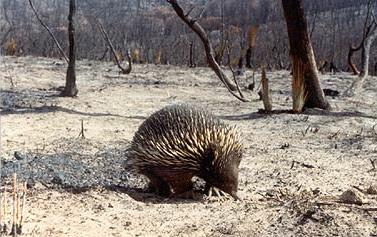
.
.
.
Wildlife Service chief boasts of mass incineration of 92,000 ha of National Parks
.
And the Wildlife Service regional chief for the Blue Mountains region, Geoff Luscombe, in his media release 17th May 2011 boasted of his:
“3000 hectare burn” that “the NPWS carried out more than 92,000 hectares of hazard reduction in 269 burns in 2009/10 – its biggest ever program.”
.
To put this area into perspective, in terms of the Blue Mountains World Heritage Area of about 1 million hectares, such a hazard reduction programme over a decade would decimate the Blue Mountains completely. And they call themselves a ‘Wildlife Service’?
Once again thousands of hectares of pristine flora and fauna habitat in deep inaccessible terrain, miles from houses and human property, has been incinerated from the air using contracted aircraft dropping indiscriminate aerial incendiaries. If only these boys had napalm!
Luscombe confirms in his media release…
“An aircraft will be used to manage the burn as most of the burn will take part in remote areas of the Blue Mountains.”
.
This incineration of natural wildlife habitat is justified by the Wildlife Service as ‘strategic‘ and ‘hazard reduction‘ operations are one of many being conducted by NPWS around the state making the most of the dry sunny winter conditions. This burn is part of the NPWS annual fire management program.
Luscombe again:
…“reducing the volume of fuels within strategic areas of the Park, can assist in limiting the intensity and rate of spread of a wildfire in the area.”
.
Then on Friday 20th May 2011, vertical plumes of smoke were seen rising from Cedar Valley south of the Jamison Valley ~ another one of these secret HR aerial incendiary black ops that the public is not supposed to know about? No notice on either the Blue Mountains Rural Fire Service site or the Wildlife Service site. Out of sight, out of mind.
.
.
.
‘Strategic Fire Management Zones’ – a symptom of a bushphobic cult out of control
.
Under the Blue Mountains Bushfire Management Committee which governs the Blue Mountains region, ‘environmental assets’ are restricted to “threatened species, populations and ecological communities and Ramsar wetlands, locally important species and ecological communities, such as species and ecological communities especially sensitive to fire.”
So how does aerial incendiary discriminate when setting fire to a contiguous 2500 hectares or 3000 hectares of wilderness?
Answer: It doesn’t , it doesn’t seek to, it doesn’t care. The guidelines are only to keep the greenies happy. It’s called ‘greenwashing’.
The Wildlife Service in its official Fire Management Strategy, has relegated 97.7% of the Blue Mountains National Park into either what it calls ‘Strategic Fire Advantage Zones’ or else ‘Heritage Zones. In essence, heritage Zones are valued natural areas that are protected from fire, whereas the Strategic Fire Advantage Zones are expendable. The Wildlife Service proclaims that …due to the ‘relative lack of practical fire control advantages’ (lack of access and resources), Strategic Fire Management Zones are ‘managed’ to protect community assets… to reduce fire intensity… assist in the strategic control… to contain bush fires and to strengthen existing fire control advantages.
All of which simply means is that it is expendable and can and should be burnt in case it burns. Strategic Fire Management Zones ‘are considered priority for ‘treatment‘ – read targeted for broadscale indiscriminate aerial incendiary. So 2500 hectares of wilderness around Massif Ridge copped it last winter and 3000 hectares of wilderness around Linden Ridge copped it this winter. If it’ red on the fire map, burn it!
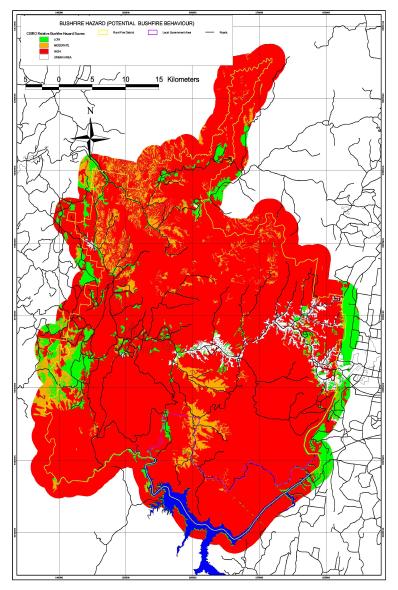
What do these ecological vandals get up to deep in the wilderness at night with their matches and petrol drip torches out of the direct view of the public? They put up signs to deny public access to their nefarious activities. Out of the public view, they are out of sight out of mind.
A cult is a group whose beliefs or practices are considered abnormal or bizarre. Starting large bushfires would seem to fit that definition. Fire-lighting is a cult of ecological deviance, just like any form of arson.
.
.
Precautionary principle ignored
.
“Where there are threats of serious or irreversible environmental damage, lack of full scientific certainty should not be used as a reason for postponing measures to prevent environmental degradation.” [Source: Principle 15 of the Rio Declaration (1992)] Such is the internationally agreed precautionary principle which Australia has adopted as a guiding principle of environmental management. The National Strategy for Ecologically Sustainable Development (1992) adopts the precautionary principle as a “core element” of ESD as does the Inter-Governmental Agreement on the Environment, and the Wildlife Service is supposed to be bound by it in its management of National Parks.
The Wildlife Service once a trusted upholder of the science-based ‘precautionary principle‘ has of late succumbed to the more red neck bushphobic fear of the bush. What the general public hears about the Wildlife Service these days is its broadscale fire bombing of vast areas of vegetation in its ‘protected’ National Parks. This is confirmed these days by the wood smoke-filled air choking many communities and responsible for unknown volumes of smoke emissions contributing to net human-caused pollution to the planet – what many call ‘climate change’.
In the Wildlife Service’s Plan of Management for the Blue Mountains National Park the only reference to the precautionary principle is “Maximum levels of total commercial recreational use in the park will be set for particular activities and particular locations according to precautionary principles.” (p.84) In its Fire Management Strategy for the Blue Mountains, the only reference to the precautionary principle is “the precautionary approach will generally be applied in the absence of specific information.” (p.53)
Clearly the Wildlife Services respect for the precautionary principle is tokenistic, and wholeheartedly disregarded with its use of aerial incendiaries. The Blue Mountains delicate ecosystems are vulnerable to the indiscriminate fire regimes being imposed upon them. The burning into the tree canopy, the broadscale contiguous burning, the scorching of the landscape until bare earth can be seen is highly damaging to the many micro ecosystem across the Blue Mountains. When such burning occurs what happens to the micro-organisms, fungi species and the natural soil biota?
.
” Much hazard reduction is performed to create a false sense of security rather than to reduce fire risks, and the effect on wildlife is virtually unknown.”
~ Michael Clarke (Associate Professor, Department of Zoology, La Trobe University, 2008)
.
.
.
.

A discredited Wildlife Service
.
The once trusted and respected Wildlife Service has lost its conservation way. It now spends more time, money and training on burning fragile ecosystems in its National Parks and exploiting those same parks for tourism exploitation, than it does on wildlife habitat rehabilitation. Sydney’s Taronga Zoo has become far more active and valuable in its urban wildlife recovery programmes than the Wildlife Service is in the wild.
At the carpark above Katoomba Falls within the Blue Mountains National Park, a rather old and deteriorating sign put up by the Wildlife Service years ago, conveys a conservation message to park users. The last two sentences are particularly poignant in light of the massive scale of broadscale bush arson repeatedly being inflicted by the protectorate of the National Park – the Wildlife Service. If only the Wildlife Service would “leave nothing but footprints” and follow its own maxim.
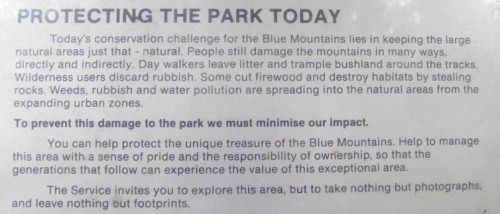
Indiscriminate bush arson of remote bushland in a National Park shows that the Wildlife Service has descended into a predatory wolf in sheep’s clothing. It’s management cannot be trusted with its custodial responsibility to protect the unique treasure of the Blue Mountains.
Once I had a desire to embark on a career as a National Parks Ranger. Had I, in the end, I would have morally wrestled with the hypocritical politics and lasted less than the initial probationary period. I empathise with those who hold a personal commitment to ecology and environmentalism within the Wildlife Service.
.
.
.
The key drivers of the ‘HR Culture’
.
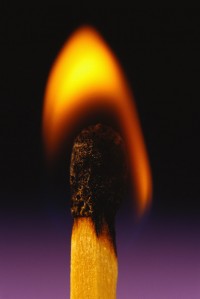
The perverted and unquestioned rush to set fire to as much bushland as possible across the Blue Mountains and indeed across Australia is being driven by five cultural factors:
- ‘Ecological Fire’ Myth. (as described above) Certain ”fire ecologists’ (a self-described term for many seeking to make this a lucrative profession) who are funded by bushfire management agencies, not surprisingly have conjured the academic theory that burning the bush is good for it because it increase biodiversity – just what bushfire management with their cheque book want to hear! They have conjured the term ‘ecological fire‘, which as a euphemism sounds good, so it must be good. So those setting fire to the bush may have no moral qualms. Crap. Show me any native fauna that proliferate after fire – ‘ecological’ or otherwise!
- Under-Resourced. Bushfire management is being repeatedly denied the necessary resources and technologies to quickly detect, respond to and suppress bushfore ignitions as and when they do occur, so there is a mindset of futile frustration that nothing can be done to stop bushfires frequently getting out of control.
- Bushphobic Extremists have become effective in their fear campaign to influence natural land managers, politicians and the media in their one dimensional theory that if bushland is not burnt to remove ‘fuel loads’ catastrophic firestorms will inevitably bring forth Armageddon. They preach that only the wholesale removal of forests will prevent wildfire. (Replacement with concrete would prevent it too.) Their constant evangelising reaches such irrational hysteria, that in order to appease them, HR Ops are promised and executed just to keep them at bay.
- False Sense of Security. ‘Much hazard reduction is performed to create a false sense of security’ (James Woodford, 8-9-2008). But how is burning remote bushland many kilometres from the human interface, allaying human security concerns? Yet hazard reduction is known to directly cause a sharp increase in fuel loads due to an unnaturally high and uniform germination of understory plants.
- Winter Idleness. Fire fighting naturally quietens off during the cooler wetter month of winter, and since Australian bushfire management agencies in the main only do bushfire management rather than throw on an SES jacket, multi-task in complimentary emergency management; many bushfire agencies are perceived (rightly or wrongly) as being idle over winter. So HR gives ’em all something to do!
.
.
.
The Wildlife Service must ‘love the smell of napalm (and smoke) in the morning’
.

The Wildlife Service undertaking these remote HR Ops, sending in the airborne firelighters, must be like watching the Huey helicopter beach attack scene in Francis Coppola’s 1979 film Apocalypse Now, based on Joseph Conrad’s novel ‘A Heart of Darkness’. Colonel Kilgore in his black Confederate cowboy hat shouts:
“We’ll come in low out of the rising sun, then about a mile out we’ll put on the music; scares the hell out of the slopes.”
Richard Wagner’s “Ride of the Valkyries” is played and the boys play war games with real aircraft and real fire and causing real death and destruction.

A giant napalm strike in the nearby jungle dramatically marks the climax of the battle. Kilgore exults to Willard, “I love the smell of napalm in the morning… The smell, you know that gasoline smell… Smells like … victory”, as he recalls a battle in which a hill was bombarded with napalm for over twelve hours.
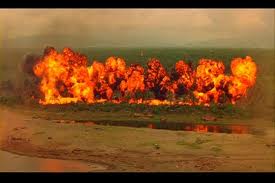
The Wildlife Service aerial incendiary boys must think of themselves as Special Forces. Perhaps there is a Colonel Kurtz among them – like an insane killer operating deep inside Laos. Kurtz’ final lines in the film are “The horror! The horror!” How comparable with what is happening deep inside Australia’s wilderness areas, out of sight out of mind? …with extreme prejudice!

How comparable is the US secret war fire bombing of Vietnam, Cambodia and Laos during the Vietnam War with the out of sight fire bombing by the Wildlife service of vast areas of Australia’s natural landscape?
The legacy of the Wildlife Services’ aerial incendiary campaigns deep inside National Parks will be one remembered for fire bombing wildlife habitat from once natural and densely vegetated into a one unnatural, sterile and ghostly quiet.
When it is too late, hazard reduction will be acknowledged by our children as naiive threatening process of our generation that drove Australia’s remaining wildlife into extinction.
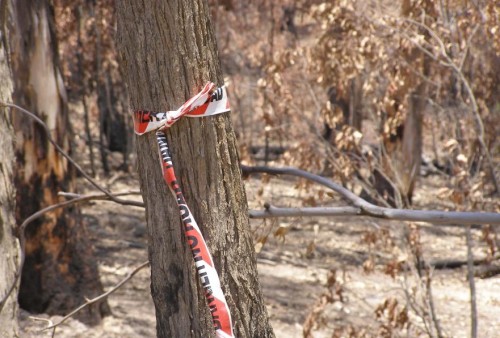
.
.
Further Reading:
[1] ‘ Catering for the needs of fauna in fire management: science or just wishful thinking?’ by Michael F. Clarke, Wildlife Research, Vol. 35 No. 5 Pages 385 – 394, Published 19 August 2008, ‘Ecological fire management in Australia is often built on an assumption that meeting the needs of plant species will automatically meet the needs of animal species. However, the scarcity of..’. ‘Wildlife Research: Ecology, Management and Conservation in Natural and Modified Habitats’, a CSIRO Journal, ISSN: 1035-3712, eISSN: 1448-5494, Available for subscription at http://www.publish.csiro.au/index.cfm
[2] ‘ The dangers of fighting fire with fire‘, by James Woodford, Sydney Morning Herald, 20080908, p.11, http://www.smh.com.au/news/opinion/the-dangers-of-fighting-fire-with-fire/2008/09/07/1220725850216.html (Accessed 20110523).
-end of article –
Tags: aerial incendiaries, applied ecology, blue labyrinth, Blue Mountains National Park, Blue Mountains wildlife, Blue Mountains World Heritage Area, bushfire myth, bushfire tolerant, bushphobic, conservation biology, ecological burn, fire-lighting cult, fuels, government bush-arson, greenwashing, Grose Valley Fires 2006, hazard reduction, heritage zone, koala extinction, leave nothing but footprints, Linden Ridge HR, Massif Ridge HR, NPWS, precautionary principle, prescribed burning, RFS, strategic fire advantage zone, strategic fire management zone, wildfire, Wildlife Service
Posted in Blue Mountains (AU), Threats from Bushfire | No Comments »
Add this post to Del.icio.us - Digg
Friday, January 28th, 2011
Australian native forests – are they valuable ecosystems and habitats for wildlife; or bushfire fuel hazards to be burned, before they burn?
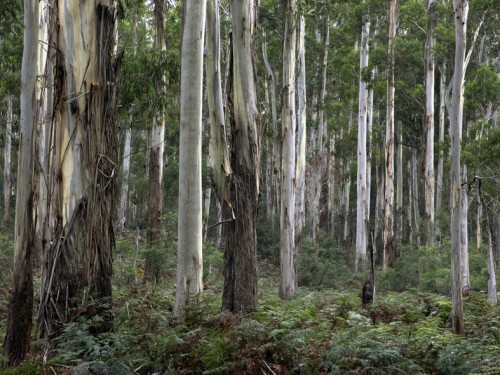 Blue Mountains wet schlerophyl forest
© Photo by Henry Gold, wilderness photographer
. Blue Mountains wet schlerophyl forest
© Photo by Henry Gold, wilderness photographer
.
.
Bushfire Management’s root problems
.
- Bushfire Management which recognises wildlife habitat as an asset worth protecting makes the fire fighting task immensely complex. So moreover the more simplistic and cost saving rationale of ‘protecting life and property’ holds sway, where no thought is given to the conservation values or to the habitat needs of wildlife. The inculcated and unquestioned bushfire management attitude that native forests are the cause of bushfires, rather than being victims of bushfires, belies one of the three key root problems of why bushfire management is failing. Ignitions left to burn in inaccessible terrain time again have proved be devastating not just for nature and wildlife, but consequentially for human life and property. Wildfire does not discriminate.
- Bushfire Management across Australia is so poorly equipped to detect and suppress ignitions when they do occur, that out of frustration, fear has been inculcated to encourage all native forests be dismissed as bushfire hazards and ‘prescribed burned’ as a precaution. Across the New South Wales Rural Fure Service, the term is quite unequivocal – ‘Hazard Reduction‘ . Broadscale hazard reduction, euphemistically labelled ‘strategic burns‘ or deceptively ‘ecological burns‘ and has become the greatest wildlife threatening process across Australia driving wildlife extinctions.’
- Both the localised and regional impacts of bushfire and hazard reduction upon wildlife ecology are not fully understood by the relevant sciences – ecology, biology and zoology. Fire ecology is still an emerging field. The Precautionary Principle is well acknowledged across these earth sciences, yet continues to be dismissed by bushfire management. They know not what they do, but I do not forgive them.
.
Australia’s record of wildlife extinctions are the worst of any country in the past two hundred years.
‘Of the forty mammal species known to have vanished in the world in the last 200 years, almost half have been Australian. Our continent has the worst record of mammal extinctions, with over 65 mammal species having vanished in the last 50 000 years.’ [Chris Johnson, James Cook University, 2006]
.
‘Australia leads the world in mammal extinctions. Over the last two hundred years 22 mammal species have become extinct, and over 100 are now on the threatened and endangered species list, compiled as part of the federal government’s Environment Protection and Biodiversity Conservation Act.’ [Professor Iain Gordon, research scientist in CSIRO’s new Biodiversity Theme, 2009.]
.
Uncontrolled bushfires, broadscale and frequent hazard reduction, and land clearing are the key drivers causing Australia’s remaining wildlife to disappear. Once habitat is destroyed, the landscape becomes favourable to feral predators which kill the remaining unprotected fauna. Thousands of hectares of Australia’s native forests are being burnt every year and are becoming sterile park lands devoid of undergrowth habitat. Wave after wave of habitat threats continue to undermine the layers of resilience of native fauna, until fauna simply have no defences left and populations become reduced to one local extinction after another.
James Woodford in his article ‘The dangers of fighting fire with fire‘ in the Sydney Morning Herald, 8th September 2008, incitefully observed:
‘Fighting fires with fear is a depressing annual event and easy sport on slow news days. Usually the debate fails to ask two crucial questions: does hazard reduction really do anything to save homes, and what’s the cost to native plants and animals caught in burn offs? What we do know is a lot of precious wild places are set on fire, in large part to keep happy those householders whose kitchen windows look out on gum trees.
Hazard reduction burning is flying scientifically blind. Much hazard reduction is performed to create a false sense of security rather than to reduce fire risks, and the effect on wildlife is virtually unknown. An annual bum conducted each year on Montague Island, near Narooma on the NSW far South Coast has become a ritual in which countless animals,including nesting penguins, are roasted.
The sooner we acknowledge this the sooner we can get on with the job of working out whether there is anything we can do to manage fires better. We need to know whether hazard reduction can be done without sending our wildlife down a path of firestick extinctions.’
.
.
‘Koalas may be extinct in seven years’
[Source: Sydney Morning Herald, 20070411]
.
‘Extreme drought, ferocious bushfires and urban development could make koalas extinct within seven years, environmentalists are warning. Alarms about the demise of the iconic and peculiar animal, which sleeps about 20 hours a day and eats only the leaves of the eucalyptus tree, have been raised before.
But Deborah Tabart, chief executive officer of the Australia Koala Foundation, believes the animal’s plight is as bad as she has seen it in her 20 years as a koala advocate.
“In South-East Queensland we had them listed as a vulnerable species which could go to extinction within 10 years. That could now be seven years,” she said. “The koala’s future is obviously bleak.”
South-East Queensland has the strongest koala populations in the vast country, meaning extinction in this area spells disaster for the future of the species, said Tabart.
The biggest threat is the loss of habitat due to road building and development on Australia’s east coast – traditional koala country. The joke, said Tabart, is that koalas enjoy good real estate and are often pushed out of their habitat by farming or development.
“I’ve driven pretty much the whole country and I just see environmental vandalism and destruction everywhere I go,” she said. “It’s a very sorry tale. There are [koala] management problems all over the country.”
Massive bushfires which raged in the country’s south for weeks during the summer, burning a million hectares of land, would also have killed thousands of koalas.’
[Read More]
.
.
‘A Bushfire action plan which protects people, property and nature’
[Source: The wilderness Society, 20090219, http://www.wilderness.org.au/campaigns/forests/bushfire-action-plan]
.
 In the immediate aftermath of the devastating Victorian Bushfires of 2009, The Wilderness Society, in response to bushfire management’s quick blaming of the native forests for the bushfires; drafted a ‘Bushfire Action Plan‘ that sought to recognise the need to protect nature along with people and their property. In the immediate aftermath of the devastating Victorian Bushfires of 2009, The Wilderness Society, in response to bushfire management’s quick blaming of the native forests for the bushfires; drafted a ‘Bushfire Action Plan‘ that sought to recognise the need to protect nature along with people and their property.
.
‘Bushfire remains one of the most complex and difficult aspects of our environment to deal with. Climate change is expected to make things even tougher, with increases in the number of high fire danger days and the number of people and houses at risk increasing with the tree/sea change phenomenon.
With the onset of climate change, mega-bushfires that burn massive areas are expected to occur more often.
A joint CSIRO and Bureau of Meteorology study of the impact of climate change in bushfires found parts of Victoria faced up to 65% more days of extreme fire risk by 2020, and 230% more by mid-century.
Yet clearly we have a lot to learn and the Royal Commission will set a new agenda for land and fire management, prevention and response. Many challenges will remain but some aspects seem clear. We need more money and support for fire fighters if we are to successfully protect life, property and the environment. Two key areas are the early detection of fires including the use of aerial surveillance and remote sensing especially in remote areas, increasing rapid response capacity including more “Elvis” helicopters to fight bushfires as soon as they start.
The outstanding work of firefighters on the front line needs to be backed up with the best available knowledge, planning and resources to ensure operations are as effective as possible in protecting people, property and nature. There is an urgent need to increase investment in these areas and rapidly establish scientific underpinning to fire management, as well as properly resourcing implementation and fire operations.
We also need more information for government and community about how to deliver fire management in a way that also protects the natural environment and our unique wildlife.
Fuel reduction burning has an important place in the fire management toolbox, and we support its place in scientifically underpinned fire management for the protection of life, property and the environment.
The issue of fuel reduction burning often dominates the fire debate, as if it is the only fire management tool. But it’s important to remember that this is only one tool in fire management, and not the silver bullet that will fire proof the landscape.
Environmental groups want to see the science that supports the current fuel reduction program, including a scientific justification for so-called hazard reduction burns in specific areas and the scientific justification for the route and extent of fire break establishment. Environmental groups are particularly concerned about the lack of impact assessment of these programs on biodiversity, particularly given their uncertain benefits to reduce the extent, frequency and severity of fire.
Views on these measures tend towards two extremes. One extreme is that we should fuel reduction burn all forest areas every 20 years and carve out thousands of kilometres of fire breaks, the other is that all our forests are wilderness areas which should just be allowed to burn and not manage our forests for fire at all.
For the Australian bush to be healthy and to protect people, property and nature we need a scientifically based balance between these extremes.
Fire management is not ‘one size fits all’ when it comes to the Australian bush. It needs to be targeted and specific, because we know that different kinds of bush respond differently to fire and therefore need different management. For native plants and animals to survive, fire management needs to promote “good” fire at the right time of year, of the right type and size. And that varies with vegetation type and resident native animals. Grasslands will require more frequent fires compared with forests, while areas such as rainforest will need to be protected from fire altogether.
That’s why we need good ecological science informing fire management, which has come a long way in understanding what’s best for native plants, but we need a better understanding of what fire management is best for protecting wildlife and avoiding extinctions. Its critical that scientists, fire agencies and governments work together to understand how to best manage fire to protect habitat for endangered wildlife, because no one wants fire management to lead to extinctions.
Of course, the protection of life & property needs to come first in fire management – but we can do that while also protecting nature and wildlife. A balanced approach is to prioritise the protection of life and property in areas close to farms and townships, and to prioritise fire management for the environment in remote areas and national parks.
A continuation of the expansion in knowledge, resources and support for fire management and community preparedness will best ensure the protection of life, property and the environment into the future…
.
We have developed a 6-point plan to reduce the bushfire risk and help protect people, property, wildlife and their habitat.
- Improve aerial surveillance to detect bushfires as soon as they start.
- Ramp up hi-tech, quick response capability, including more ‘Elvis’ helicopters to fight bushfires as soon as they ignite.
- More research into fire behaviour and the impact of fire on wildlife and their habitat.
- Around towns and urban areas – prioritise the protection of life and property with fuel reduction and fire break management plans.
- In remote areas and National Parks – prioritise the protection of wildlife and their habitat through scientifically-based fire management plans.
- Make native forests resistant to mega-fires by protecting old-growth forests, rainforests and water catchments from woodchipping and moving logging into existing plantations.
.
.
Critique of Roger Underwood’s Criticism of TWS ‘6-Point Plan‘
.
 On 12th February 2009, Roger Underwood, a former rural firefighter and a forestry industry employee in Western Australia, had his article published in The Australian newspaper criticising the above recommendations of The Wilderness Society (TWS). On 12th February 2009, Roger Underwood, a former rural firefighter and a forestry industry employee in Western Australia, had his article published in The Australian newspaper criticising the above recommendations of The Wilderness Society (TWS).
Regrettably, rather than offering constructive criticism and proposing counter arguments with supportive evidence, Underwood instead dismisses the Wilderness Society’s contribution, but disappointingly with empty rhetoric. Underwood states upfront:
“the trouble with the society’s action plan to reduce the risk of bushfires is that it won’t work.“
.
The Wilderness Society’s six-point action plan aims to counter the current bushfire management strategy that relies upon hazard reduction burning and the ecological damage this is causing – ‘destroying nature’, ‘pushing wildlife closer to extinction’, ‘increasing the fire risk to people and properties by making areas more fire prone’.
Underwood claims that statistics exist showing no massive increase in prescribed burning, but in fact that prescribed burning has declined. Yet Underwood fails to provide nor even reference any such statistics. He fails to recognise that both bushfires and prescribed burning collectively cause adverse impacts on wildlife. If all burning of native vegetation, however caused, is included in the assessment, then would statistics indeed show an increasing trend in the natural area affected by fire in Australia?
.
‘Burn it before it burns’ Theory
.
Underwood questions the wildlife extinction problem without any basis. He then adopts the ”old chestnut‘ theory of blaming the threat to wildlife on ‘killer bushfires‘. ‘Killer bushfires’ (the firestorm threat) has become the default justification by bushfire management for its policy of prescribed burning. This is the ‘Burn it before it burns!‘ defeatist attitude. If one burns the bush, there will be no bush to burn. Underwood’s claim that ‘killer bushfires’ are a “consequence of insufficient prescribed burning” is a self-serving slippery slope fallacy. If nature is an asset of value to be protected, then it is defeatist to damage it to prevent it from damage. The history of so-called ‘controlled burns‘ have an infamous reputation of getting out of control and becoming wildfires. If the attitude of burning as much of the bush as possible to avoid uncontrolled wildfire, then then paradoxically the implied incentive is to let controlled burns burn as much as possible to minimise the risk of unexpected fires in the same area.
.
In respect to each of The Wilderness Society’s (TWS) Six Point Plan, one counters Underwood’s responses as follows:
.
1: Improve aerial surveillance to detect bushfires as soon as they start
.
Underwood supports aerial detection as “a first-rate resource and a comprehensive system” but says that it can fail completely under hot, unstable atmospheric conditions and when there are very high winds. However, fire towers and aircraft are not the means of bushfire surveillance today. Low orbiting geostationary satellites with infrared and high resolution cameras can now spot individual cars in real time and through cloud and smoke. Satellites are not affected by atmospheric conditions such as high winds or hot temperatures. Modis-Fire is one company that specialises in such satellite technologies.
In addition, the CSIRO, with the Department of Defence and Geoscience Australia, has developed an internet-based satellite mapping system called ‘Sentinel Hotspots‘. Sentinel Hotspots gives emergency service managers access to the latest fire location information using satellite data. Fire fighting organisations across Australia have used this new strategic management tool, since it was launched in 2002, to identify and zoom in on fire hotspots. [Read More]
In 2003, an article in the International Journal of Wildland Fire entitled ‘Feasibility of forest-fire smoke detection using lidar‘ extolled the virtues of forest fire detection by smoke sensing with single-wavelength lidar.
Such technologies are available if the political will was met with appropriate investment. Such technologies could be available to a military-controlled national body, but unlikely to be available to volunteer members of the public. It all depends on the standard of performance Australians expect from bushfire management.
.
2: Ramp up hi-tech, quick response capability, including more ‘Elvis’ helicopters to fight bushfires as soon as they ignite.
.
Underwood dismisses aerial fire-bombing as a “dream” that “has never succeeded in Australia, and not even in the US” and “next to useless“.
Well, it seems Underwood is contradicted by the recent decisions of Australia State Governments across Australia’s eastern seaboard to charter not just one Erikson Aircrane but three. Not only was Elvis contracted from the United States in Summer 2010 to Victoria, “Elvis” was based in Essendon, ‘Marty‘ was based in Gippsland and ‘Elsie‘ was based in Ballarat. Clearly, the Victorian State Government considers the cost of these three aircraft justifiably cost-effective in offering quick response capability to fight bushfires.
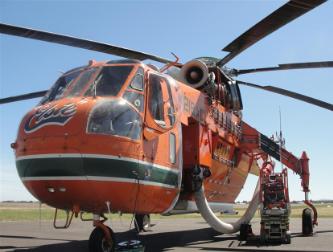 Dedicated Fire Fighting Erikson Aircrane ‘Elsie‘ based in Ballarat, Victoria during the 2010 Summer
© Photo ABC Ballarat http://www.abc.net.au/local/audio/2010/12/22/3099609.htm
.
In South Australia, the Country Fire Service (CFS) believes in the philosophy of hitting a fire ‘hard and fast’.
.
‘CFS volunteers and aerial firefighting aircraft are responded within minutes of a bushfire being reported and as many resources as possible are deployed to keep the fire small and reduce the chance of it getting out of control. It is not widely known that South Australia has a world class initial attack strategy of aerial firefighting. The value of a rapid aerial firefighting approach has been supported by Bushfire Cooperative Research Centre research. In their 2009 report titled ‘The cost-effectiveness of aerial fire fighting in Australia, the Research Centre wrote the following in their summary
.
The results of the analysis show that the use of ground resources with initial aerial support is the most economically efficient approach to fire suppression. Aircraft are economically efficient where they are able to reach and knock down a fire well before the ground crew arrives. This buys time for the ground forces to arrive and complete the containment. Rapid deployment of aerial suppression resources is important. This advantage is much greater in remote or otherwise inaccessible terrain. Where other suppression resources are unable to reach the fire event within a reasonable time period, sole use of aircraft is economically justified.’
[http://www.bushfirecrc.com.au/research/downloads/The-Cost-Effectiveness-of-Aerial-Fire-Fighting-in-Australia.pdf].
. Dedicated Fire Fighting Erikson Aircrane ‘Elsie‘ based in Ballarat, Victoria during the 2010 Summer
© Photo ABC Ballarat http://www.abc.net.au/local/audio/2010/12/22/3099609.htm
.
In South Australia, the Country Fire Service (CFS) believes in the philosophy of hitting a fire ‘hard and fast’.
.
‘CFS volunteers and aerial firefighting aircraft are responded within minutes of a bushfire being reported and as many resources as possible are deployed to keep the fire small and reduce the chance of it getting out of control. It is not widely known that South Australia has a world class initial attack strategy of aerial firefighting. The value of a rapid aerial firefighting approach has been supported by Bushfire Cooperative Research Centre research. In their 2009 report titled ‘The cost-effectiveness of aerial fire fighting in Australia, the Research Centre wrote the following in their summary
.
The results of the analysis show that the use of ground resources with initial aerial support is the most economically efficient approach to fire suppression. Aircraft are economically efficient where they are able to reach and knock down a fire well before the ground crew arrives. This buys time for the ground forces to arrive and complete the containment. Rapid deployment of aerial suppression resources is important. This advantage is much greater in remote or otherwise inaccessible terrain. Where other suppression resources are unable to reach the fire event within a reasonable time period, sole use of aircraft is economically justified.’
[http://www.bushfirecrc.com.au/research/downloads/The-Cost-Effectiveness-of-Aerial-Fire-Fighting-in-Australia.pdf].
.
Underwood claims that: “Elvis-type aircranes cost a fortune, burn massive amounts of fossil fuel, use gigalitres of precious water and are ineffective in stopping the run of a crown fire that is throwing spot fires. Water bombers do good work protecting houses from small grass fires. But against a big, hot forest fire and during night-time they are next to useless.”
Underwood conveys a sense of dogged reliance in traditional fire truck centric thinking as if to preserve an old firie culture of ‘we know best‘ and ‘nothing is going to change our thinking‘ mindset. May be it is out of petty envy wherein many volunteer firies can command trucks but wouldn’t have a clue flying helicopters and so would feel sidelined.
Well, since the 2009 Victorian Bushfires, more than A$50 million worth of new initiatives have been introduced or are under development.
“Further changes are likely to be introduced as the Royal Commission, which was established to investigate the Black Saturday disaster, is ongoing. Aerial firefighting is set to be addressed by the commission. Among new initiatives in Victoria is a A$10 million trial of a very large air tanker (VLAT) – the first-ever such experiment in the country. On 14 December, a McDonnell Douglas DC-10-30 Super Tanker, leased from US company 10 Tanker Air Carrier, arrived in Melbourne. Australian regulator, the Civil Aviation Safety Authority, and underwent final compliance assessment to allow it to enter service in January.”
.
[Source : http://www.flightglobal.com/articles/2010/02/09/338056/australia-puts-firefighting-tankers-to-the-test.html]
Underwood may well dismiss aerial suppression technology as ‘razzle-dazzle‘, but he is right to state that such investment requires governments to put more resources into research and into monitoring bushfire outcomes, including the environmental impacts of large, high-intensity bushfires and continuous feedback to management systems from real-world experience out in the forest.’
.
3: More research into fire behaviour and the impact of fire on wildlife and their habitat
.
While Underwood claims that he supports more research into fire behaviour and fire impacts, he is dismissive of the conclusions of much of the research already done, but offers no explanation. This seems an internal contradiction. What are the conclusions of the research?
Underwood claims the conclusions do not support the Wilderness Society’s agenda. How so? What is TWS agenda?
Underwood conveys an unsubstantiated bias against the Wilderness Society, only offering an ad hominem fallacious argument – attacking the messenger, not the argument.
.
The science on fire ecology is still emerging. The Wilderness Society validly states above that ‘bushfire remains one of the most complex and difficult aspects of our environment to deal with‘, that ‘there is an urgent need to increase investment in these areas and rapidly establish scientific underpinning to fire management, as well as properly resourcing implementation and fire operations‘ and ‘the lack of impact assessment of these programs on biodiversity, particularly given their uncertain benefits to reduce the extent, frequency and severity of fire‘.
.
4: Around towns and urban areas – prioritise the protection of life and property with fuel reduction and fire break management plans.
.
Underwood here perceives an inconsistency in TWS Action Plan – suggesting its support for fuel reduction around urban areas contradicts its claim that fuel reduction makes the burned areas “more fire prone”. However, this action item is about prioritising fuel reduction on a localised basis around the immediate areas where life and property are located.
Whereas broadscale hazard reduction that is carried out many miles from human settlements has become a new strategy of bushfire management. The excuse used is euphemistically termed a ‘strategic burn‘ or even an ‘ecological burn‘ in the name of encouraging biodiversity. Except that the practice seems to be a leftover habit from the Vietnam War in which helicopters are used to drop incendiaries indiscriminately into remote areas without any care for the consequences.
 A so-called ‘ecological burn‘ of Mt Cloudmaker
This was conducted by helicopter incendiary by NSW National Parks and Wildlife Service (DECCW)
in the remote Krungle Bungle Range of the Blue Mountains World Heritage Area
(Photo by editor from Hargraves Lookout, Shipley Plateau, 20080405 , free in public domain) A so-called ‘ecological burn‘ of Mt Cloudmaker
This was conducted by helicopter incendiary by NSW National Parks and Wildlife Service (DECCW)
in the remote Krungle Bungle Range of the Blue Mountains World Heritage Area
(Photo by editor from Hargraves Lookout, Shipley Plateau, 20080405 , free in public domain)
.
A recent example is the ‘strategic burn’ authorised and executed by the NSW Department of Environment, Climate Change and Water (DECCW) in the Blue Mountains World Heritage Area on 12th May 2010. Some 2500 hectares of remote wilderness was deliberately set alight around Massif Ridge, some 12 kilometres south of the town of Woodford in wild inaccessible forested area of the World Heritage Area. The excuse was to reduce the available ‘fuel’ (native vegetation) for potential future wildfires. [>Read More: ‘National Parks burning biodiversity‘ ]
.
5: In remote areas and National Parks – prioritise the protection of wildlife and their habitat through scientifically-based fire management plans.
.
Underwood contends another stock standard industry claim that where native forests have been protected, they have naturally accumulated fuel loads in which sooner or later an uncontrollable landscape-level fire occurs. So his anthropocentric theory runs that is humanity’s responsibility not to let nature be nature, but to control nature and so to burn the bush before it burns. This theory is premised on the defeatist approach that in the event of a bushfire, bushfire management is not in a position to detect and suppress it.
And so Underwood, poses the standard industry response of “more frequent planned burning under mild conditions“. He assumes that leaving the overstorey and the soil intact will ensures a diversity of habitat for wildlife. Yet Underwood is not a zoologist and has no understanding of the vital role that dense ground vegetation provides to Australia’s native ground dwelling mammals (e.g.the Long-footed Potoroo, Spotted-tailed quoll, Eastern Pygmy Possum, the Petrogale penicillata, Broad-toothed Rat, Bolam’s Mouse, the Smoky Mouse, the Eastern Chestnut Mouse, the Long-nosed Bandicoot), as well as nexting birds, flightless birds, amphibians and reptiles.
 Eastern Quoll – Dasyurus viverrinus – EXTINCT on mainland Australia
© Photo by Andrea Little http://www.mtrothwell.com.au/gallery.html Eastern Quoll – Dasyurus viverrinus – EXTINCT on mainland Australia
© Photo by Andrea Little http://www.mtrothwell.com.au/gallery.html
.
Underwood’s view reflects the simplistic misguided view of biodiversity of most of Australia’s bushfire management – that the presence of trees and regrowth of fire-tolerant plants equates to biodiversity.
Can Underwood name one species of Australian fauna that is fire tolerant?
Underwood misinterprets the text of TWS which advocates an holistic fire management system, not as a silver bullet or ‘one-size-fits- all’ convenient panacea that pretends to fire proof the landscape. The only guarantee of ‘one-size-fits- all’ hazard recution is a sterile forest devoid of biodiversity and causing local species extinctions. TWS argues for a scientifically-based and balance approach recognising that some forest ecosystems like rainforests are most definitively fire-intolerant.
.
6: Make native forests resistant to mega-fires by protecting old-growth forests, rainforests and water catchments from woodchipping and moving logging into existing plantations
Underwood challenges this last item stating there is no evidence that old growth forest is less likely to burn than the regrowth forests. This is false. Australian native forests that regrow after fire are those that are fire-resistant. Typically, these genus (Eucalypt and Acacia) regrow quickly and become dense mono-cultures. If a fire passes through again, the fire is often more intense and devastating. Old growth forests, rainforests and riparian vegetation around water catchments tend to be moist and so less prone to bushfires.
But this sixth item is not about the relative propensity of old growth forests to burn more readily than regrowth forests, so Underwood’s argument is a distracting red herring. TWS’ aim here is more about placing a higher value on old growth and rainforests due to their greater biodiversity and due to their increasing scarcity. Clearly, TWS is ideologically opposed to woodchipping and logging of old growth forests and rainforests. Logging operations typically involve follow up deliberate burning and such fires have frequently got out of control. Underwood’s needling criticism of TWS for having a lack of knowledge of fire physics or bushfire experience is a typical defensive criticism leveled at anyone who dares to challenge bushfire management. Conversely, if Underwood has the prerequisite knowledge of fire physics or bushfire experience, he is not very forthcoming except to defend the status quo of bushfire management.
The recent bushfire results are demonstrating that bushfire management is increasingly unable to cope with bushfire catastrophes nor meet the expectations of the public to protect life, property and nature.
.
.
Further Reading:
.
[1] ‘Studies of the ground-dwelling mammals of eucalypt forests in south-eastern New South Wales: the species, their abundance and distribution‘ by PC Catling and RJ Burt, CSIRO, 1994, http://www.publish.csiro.au/paper/WR9940219.htm
.
[2] ‘Australia’s Mammal Extinctions – A 50,000-Year History‘, by Chris Johnson, 2006, James Cook University, North Queensland. http://www.cambridge.org/aus/catalogue/catalogue.asp?isbn=9780521686600
.
[3] ‘Solving Australia’s mammal extinction crisis‘, (2009) by Professor Iain Gordon, research scientist in CSIRO’s new Biodiversity Theme, ABC Science programme. He chaired a symposium on Australia’s mammal extinction crisis at the 10th International Congress of Ecology in Brisbane August 2009. http://www.abc.net.au/science/articles/2009/09/02/2674674.htm
.
[4] ‘Koalas may be extinct in seven years‘ , Sydney Morning Herald, 20070411, http://www.smh.com.au/news/environment/koalas-may-be-extinct-in-seven-years/2007/04/11/1175971155875.html
.
[5] ‘A Bushfire action plan which protects people, property and nature‘, The Wilderness Society, 20090219, http://www.wilderness.org.au/campaigns/forests/bushfire-action-plan
.
[6] ‘Manage bush better so climate won’t matter‘, by Roger Underwood (ex-firefighter), The Australian newspaper, 20090212, http://www.theaustralian.com.au/news/manage-bush-better-so-climate-wont-matter/story-e6frg73o-1111118824093
.
[7] ‘Locating bushfires as they happen‘, CSIRO – Sentinel Hotspots, http://www.csiro.au/solutions/Sentinel.html
.
[8] ‘Modis-Fire’ satellite bushfire detection, http://modis-fire.umd.edu/Active_Fire_Products.html
.
[9] ‘Elsie’s first day on the job, Ballarat’s fire fighting helicopter‘, by Prue Bentley (ABC TV Ballarat), 20101222, http://www.abc.net.au/local/audio/2010/12/22/3099609.htm
.
[10] ‘South Australia – Country Fire Service – Factors that influence aircraft selection‘ – http://www.cfs.sa.gov.au/site/about_us/aerial_firefighting/aircraft_selection.jsp
.
[11] ‘Australia puts firefighting tankers to the test‘, Fight Global 20090209, http://www.flightglobal.com/articles/2010/02/09/338056/australia-puts-firefighting-tankers-to-the-test.html
.
[12] ‘Bushfire-CRC – Aviation content’, http://www.bushfirecrc.com/category/bushfiretopic/aviation.
.
[13] ‘Towards New Information Tools for Understanding Bushfire Risk at the Urban Interface‘, 2004, R. Blanchi, J. Leonard, D. Maughan, Bushfire-CRC, CSIRO Manufacturing & Infrastructure Technology, Bushfire Research. [Read full report]
[end of article]
.
Tags: Australian native forests, Blue Mountains wildlife, broadscale burning, bushfire action plan, Bushfire-CRC, Chris Johnson, CSIRO, dangers of fighting fire with fire, eastern quoll, ecological burn, Erikson Aircrane, fire-intolerant, fuel reduction, fuel reduction program, ground dwelling mammals, hazard reduction, Henry Gold, koala extinction, mammal extinctions, Modis Fire, Montague Island hazard reduction, precautionary principle, precribed burning, Professor Iain Gordon, Roger Underwood, Rural Fire Service, Sentinel Hotspots, sterlisation of forests, strategic asset management, The Wilderness Society, threatening process, Victorian Bushfires 2009, wildfire, wildlife extinctions, wildlife habitat
Posted in Blue Mountains (AU), Threats from Bushfire | No Comments »
Add this post to Del.icio.us - Digg
|
|
 NSW National Parks and Wildlife Service setting fire to native habitat while the weather is calm.
What fauna, it’s an ‘Ecological Burn’?
This week’s hazard reduction burn in Barrington Tops NP, north of Dungog
[Source: Photo by Andy Boleyn, ^http://newcastleonhunter.com/2012/08/npws-burning-down-the-tops/]
NSW National Parks and Wildlife Service setting fire to native habitat while the weather is calm.
What fauna, it’s an ‘Ecological Burn’?
This week’s hazard reduction burn in Barrington Tops NP, north of Dungog
[Source: Photo by Andy Boleyn, ^http://newcastleonhunter.com/2012/08/npws-burning-down-the-tops/]
 Dropping petrol bombs by immoral helicopter pilots
Dropping petrol bombs by immoral helicopter pilots Aerial ‘habitat reduction’ occurs across National Parks and World Heritage Areas
– no habitat is sacrosanct.
It is euphemistically branded ‘Biodiversity Burning’ – fire is good for wildlife – watch them run, watch the Echinas and Wombats burn!
Aerial ‘habitat reduction’ occurs across National Parks and World Heritage Areas
– no habitat is sacrosanct.
It is euphemistically branded ‘Biodiversity Burning’ – fire is good for wildlife – watch them run, watch the Echinas and Wombats burn!
 National Parks are deemed by Australian governments as a ‘hazards’!
It is a town park mentality – a bit of greenery for people to enjoy at weekends.
National Parks are deemed by Australian governments as a ‘hazards’!
It is a town park mentality – a bit of greenery for people to enjoy at weekends.
 This is Destination New South Wales..
about 90% deforested, or burned, or farmed, or mined, or housed or else deserted
This is Destination New South Wales..
about 90% deforested, or burned, or farmed, or mined, or housed or else deserted
 Broadscale Hazard Reduction
‘So when summer comes we should be right – there’ll be nothing left to burn!’
‘Job Done!‘
Broadscale Hazard Reduction
‘So when summer comes we should be right – there’ll be nothing left to burn!’
‘Job Done!‘
 Woops, the prescribed burn got out of control
That’s ok its only Fraser Island World Heritage – it’ll grow back!
Woops, the prescribed burn got out of control
That’s ok its only Fraser Island World Heritage – it’ll grow back!
 Government-sanctioned arsonists know what they are doing is wrong
– but the Firie peer pressure is too great
Government-sanctioned arsonists know what they are doing is wrong
– but the Firie peer pressure is too great




































